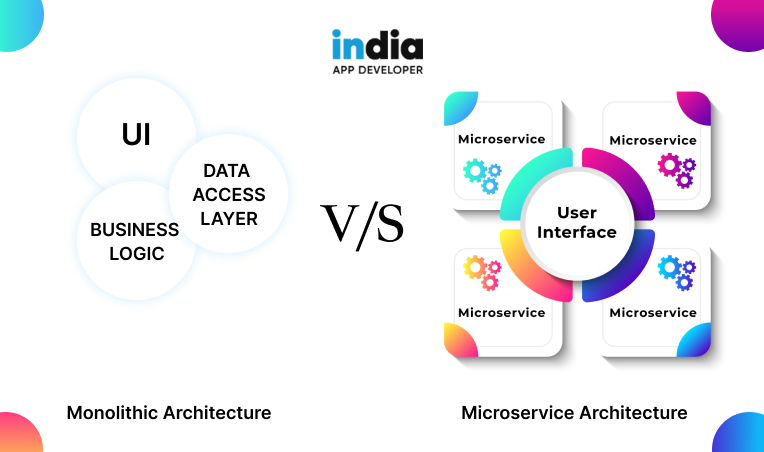In today’s digital age, companies are seeking custom software development company india to enhance their operational efficiency, customer engagement, and revenue generation. Software development companies in India offer a range of custom software development services to help businesses achieve their goals. However, the success of a custom software development project largely depends on the choice of architecture.
In the world of software development, two main types of architecture are commonly used: monolithic and microservices. Our company recognizes that both architectures have their unique advantages and disadvantages. Ultimately, the decision between the two depends on the specific requirements of the project. In this article, we will explore the differences between monolithic and microservices architecture and how they can impact custom software development services in India.
Monolithic Architecture
At India App Developer, We offers monolithic architecture as a software development approach. This architecture involves building an application as a single unit, with all components tightly integrated and dependent on each other. It is a traditional approach that has been used for many years and is still widely used today. With monolithic architecture, the entire application is deployed as a single unit, making it easier to manage and maintain. However, it can also be more difficult to scale and update individual components without affecting the entire system. Our team of experts can help you determine if monolithic architecture is the right approach for your software development needs.
Advantages of Monolithic Architecture
- Our company recognizes monolithic architecture as a traditional approach to building software where the entire application is built as a single, unified unit. The application consists of a single codebase and is deployed as a single unit. Our architecture is designed to be simple and easy to develop. Our application’s components, such as the user interface, business logic, and data storage, are closely connected and operate as a unified process.
- One of the biggest advantages of monolithic architecture, from a company perspective, is its simplicity. Developers only need to work with a single codebase, which makes it easier to understand and maintain the code. Our application is designed to be easily deployable and scalable, as it only requires one deployment for the entire system. Moreover, testing and debugging are simpler since all components of the application are tightly coupled and run in a single process.
Disadvantages of Monolithic Architecture
- However, monolithic architecture also has some drawbacks. One of the biggest issues that the company faces is scalability. As our application grows in size and complexity, it becomes more challenging to scale and maintain. As a company, we understand that adding new features or modifying existing ones can be a complex task that requires careful consideration to avoid disrupting the entire application. Furthermore, scaling the application horizontally may pose a challenge as all components are closely interconnected.
- Another issue that the company needs to consider is the risk of downtime. If one part of our application fails, it can cause the entire application to go down, which can make it challenging for our team to identify and resolve the issue. This can lead to a negative impact on business operations and customer satisfaction.
Microservices Architecture
Our company is implementing a microservices architecture. This approach involves breaking down our software applications into smaller, independent services that can communicate with each other through APIs. By doing so, we can achieve greater flexibility, scalability, and resilience in our systems. Each microservice is designed to perform a specific function, and can be developed, deployed, and scaled independently of other services. This allows us to make changes and updates to our applications more quickly and efficiently. Overall, our adoption of a microservices architecture will help us to better meet the needs of our customers and stay competitive in our industry.
Microservices architecture is a modern approach to building software where the application is broken down into small, independent services that communicate with each other using APIs. Our company ensures that each service is accountable for a particular business capability and can be created and implemented separately from the rest.
Advantages of Microservices Architecture
- The Microservices Architecture offers several advantages, including increased scalability, flexibility, and resilience. It allows for the development of complex applications by breaking them down into smaller, independent services that can be developed, deployed, and scaled independently. This approach also enables faster development and deployment cycles, as well as easier maintenance and updates. Additionally, Microservices Architecture promotes a more modular and agile approach to software development, which can lead to increased innovation and improved customer experiences.
- One of the biggest advantages of microservices architecture is its scalability. Our company’s services are designed to be independent of each other, allowing for easy scalability to meet the unique requirements of each application. This makes it easier to handle high traffic and spikes in demand. One of the advantages of our services is that they can be developed and deployed independently. This makes it easier for us to add new features and fix issues without affecting the entire application.
- Our company believes that microservices architecture is a more fault-tolerant approach as it ensures that a failure in one service does not bring down the entire application. The other services can continue to function, and the failed service can be fixed or replaced without impacting the rest of the application. Better application uptime results in improved business operations and increased customer satisfaction.
- Microservices architecture also allows for better flexibility in development and deployment. Our company’s services are designed to be independent, making it easier for us to experiment with new technologies or approaches without affecting the rest of the application. Furthermore, our company allows for the development and deployment of each service by separate teams, resulting in improved collaboration and expedited development cycles.
Disadvantages of Microservices Architecture
- However, microservices architecture also has some disadvantages. One of the biggest challenges that our company faces is the complexity of our system. Managing the interdependencies between multiple services that need to communicate with each other can be a challenging task. Furthermore, managing multiple services can add to the complexity of deployment, monitoring, and testing, increasing overhead for the company.
- Another challenge that companies face is the increased development effort required to build a microservices architecture. Developing and maintaining multiple services requires more resources and expertise than building a monolithic application. Furthermore, the development process may become more complex as each service requires individual testing and deployment.
You can also find Why IT Support and Services are Crucial for Every Company
Choosing the Right Approach for Custom Software Development Services in India
Choosing between monolithic and microservices architecture largely depends on the specific needs of the project. If the project is relatively small and simple, monolithic architecture may be the better option. Developing, deploying, and maintaining monolithic applications is easier, and there are ample resources available to assist developers in building and maintaining them.
From a company perspective, if the project is large and complex with many interdependent services, it may be more beneficial to opt for a microservices architecture. Our solution offers greater scalability, fault-tolerance, and flexibility, which are critical for large, complex applications. Furthermore, our platform enables improved collaboration and accelerated development cycles, resulting in faster time-to-market and enhanced customer satisfaction.
Custom software development companies in India can help businesses choose the right architecture for their custom software development project. Our team possesses the necessary expertise and experience to comprehend the unique requirements of each project and suggest the most suitable approach accordingly.
Conclusion
Choosing between monolithic and microservices architecture is an important decision for businesses looking to develop custom software. We believe that microservices architecture offers greater scalability, fault-tolerance, and flexibility compared to monolithic architecture, despite being more complex to maintain. Custom software development companies in India can help businesses choose the right architecture based on their specific needs and requirements. Ultimately, the success of a custom software development project depends on choosing the right architecture and developing a robust, reliable, and scalable application that meets the needs of the business and its customers.
Contact Us for More details.


